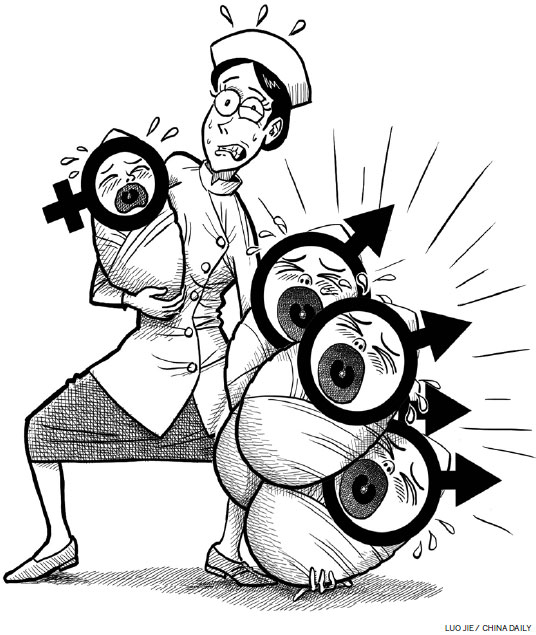China's demographic dividends have been deteriorating since the early 1980s because of the family planning policy, under which most urban couples could have only one child. Among the problems it has created is the yawning gender imbalance.
Before 1980, China had had a normal gender ratio at birth (about 102-107 boys born for every 100 girls). But after the family planning policy came into effect, an imbalance started becoming evident in the gender ratio at birth. In 2010, there were 119 boys for every 100 girls at birth; the figure for 2012 was 117.7.
The gender imbalance since the 1980s has created tens of millions of bachelors. In fact, from 1983 to 2010, more than 41 million more boys than girls were born, and from 2001 to 2010, an average of 1.3 million more boys were born every year.
According to the 2012-13 Survey Report on Chinese People's Love and Marriage Values, prepared jointly by the National Population and Family Planning Commission and popular dating website jiayuan.com, the ratio of unmarried men to women among the post-1980s generation is 136:100 - the ratio in the post-1970s generation is even more alarming 206:100.
China's sixth national census conducted in 2010 shows that about 11.96 million men in their thirties remain unmarried, while the corresponding figure for women is 5.82 million.
The effects of gender imbalance can be dangerous and long lasting. First, it indicates female feticide. Data provided in the 2012 China Health Statistical Yearbook show that about 275 million induced abortions were performed from 1980 to 2009, with the abortion of female fetuses being disproportionately higher.
Second, the problem created by "leftover" men at the grassroots and "leftover" women among the upper middle class and rich could lead to mismatched demographics and further reduce the fertility rate. "Leftover" refers to people who cannot get married for want of resources and/or ideal partners.
Third, the deepening phenomenon of leftover men could lead to sex-related crimes, disrupt the social order and increase the risk of social instability.
Leftover men are becoming a serious social problem, especially because most of them come from poor backgrounds. According to a study conducted by the Institute for Population Study and Development of Xi'an Jiaotong University in 2010, which covered 369 administrative villages across 28 provinces, there were at least nine bachelors with an average age of 41.4 years in every village.
Estimates show that from this year onward, more than 10 percent of Chinese men of marriageable age will remain unmarried because they won't be able to find suitable women for marriage. Media reports say that leftover men are concentrated in the countryside where young women tend to migrate to towns and cities to work or to get married.
The gender imbalance at birth can be attributed to couples' preference for boys as well as the family planning policy. Over the past three decades, China has focused on controlling the population by maintaining a low fertility rate and, in the process, ignored the imbalance in the gender ratio and the population's age structure.
Although the traditional preference for boys is mainly to blame for the gender imbalance, the one-child policy for most Chinese couples has also had a role to play in creating the situation that the country finds itself in today. Besides, couples have grossly misused the ultrasound technology to identify and abort female fetuses.
Having realized the problems, we need to take measures to solve them. For example, the family planning policy needs further adjustment. Eligible couples who can afford to have two children should be encouraged to do so by being educated about its advantages for their children as well as the sustainable development of the country.
Based on the trials of allowing couples to have a second child in four cities - Enshi in Hubei province, Yicheng in Shanxi province, Chengde in Hebei province and Jiuquan in Gansu province - Yi Fuxian, an expert in demographics, found that for every girl below four years of age, there were 1.12 boys in the pilot cities. This contrasts with the national average of 1.19 boys for every girl.
Allowing couples to have a second child can restore the gender ratio to a certain extent. But we should be careful with the encouragement policy, for simply allowing people to have more children cannot solve the gender imbalance problem.
The family planning policy reform - allowing couples one of whom is an only child to have two children - can correct the skewed gender ratio at birth, but only to a limited degree. It cannot necessarily restore the gender ratio at birth to normal.
We have to learn from successful practices of other countries, too, and enact laws to ban identifying the gender of fetuses and strictly implement them to stop female feticide.
The health and family planning authorities have the obligation to set up a comprehensive mechanism and to strictly implement the laws and regulations. A new work assessment system, aimed at promoting gender equality and optimizing the demographic dividends, should be established to prompt officials to focus on a balanced and sustainable population development.
The author is a professor at the Population Research Institute of Peking University.

(China Daily 12/03/2013 page9)
|